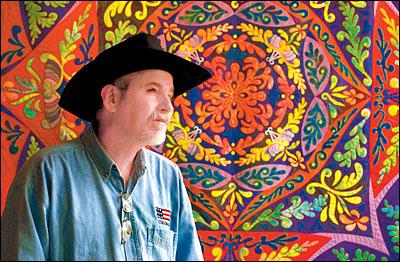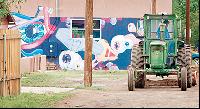|
|
Corraling Creativity
by Dana Coffield, Denver Post Staff Writer
La Veta - Sometimes it takes an extra day or two to receive supplies shipped from Denver. The Internet access is a little suspect, and the cellphone coverage in Ricky Tims' new hometown is spotty, at best. But the world-renowned cowboy quilter would not have it any other way.

"It's the price you pay for living in paradise," says Tims, whose first La Veta Quilt Retreat last month drew 13 professional quilters from California, Florida, Alabama and eight states in between. They came for a week of self-examination and expression stitched into intricate, elegant modern fiber art. The seminar and a dazzling solo gallery show of Tims' quilts - which command sums just shy of $100,000 - also brought a PBS film crew and a pack of reporters to an outpost in one of Colorado's poorest counties, where the pursuit of art has started to recharge a flagging economy.
"Those quilts are fantastic, and the workshop brought attention to La Veta," says shopkeeper Karen Bayci, 47. "People like that have been a blessing to this community." Like many small Colorado towns, La Veta is struggling to revive a mostly agricultural community without dumping its distinctive character or giving in to galloping development carved from huge family ranches.
"Me, I hate development," says Darrell Arnold, a fifth-generation resident and town trustee who brought his job to La Veta in 1990, when he launched Cowboy magazine, which celebrates ranch life. "But I'd hate to see the town die too." There are fewer than 9,000 residents in Huerfano County, which straddles Interstate 25 north of Trinidad. The major employers are schools, a prison in Walsenberg, and a hospital and veteran's home on the road to La Veta. And at the moment, the main industry in town is real estate. "We have one grocery store, two gas stations and about a zillion real estate offices," Arnold says. "I think there are about 30 Realtors in a town of 900."
Many of the folks buying in La Veta and into the village of Cuchara and the Cuchara Mountain Resort development live there only during summer. But along with well-heeled travelers from Texas, Kansas and Oklahoma have come a cadre of creative types and entrepreneurs. They are investing money and energy into filling the economic void left when the Cuchara ski area was shuttered in 2000. Although many still hold out hope that Cuchara will be revived as a year-round resort, they are focused on creating a life after skiing for La Veta.
Historic sandstone and adobe buildings lining the town's mostly dirt streets have been filled with a bakery, a gym and bike shop, galleries, tiny shops and a school that draws well-known artists from around the world to teach two- and three-day classes in sculpting, drawing and painting. There's a century bike race every August, and this year the town has added a showcase for local musicians, LaVetaPalooza Music Festival, 1-9 p.m. June 25.
 |
|
"What's going on here is progressive growth," says La Veta Inn manager Nancy McLaughlin, 63, who moved from Jefferson County in 1995. "The arts thing is really starting to explode." |
Tims and his partner, Justin Shults, 40, were living in Arvada, trying to figure out how to make their dream of opening a quilting retreat center happen. Tims - a professional musician until "quilting snuck up on me and settled into a full-time career" - teaches worldwide, but wanted a place where his students could spend time. They found a mystical piece of property on the north side of Mount Mestas, northwest of La Veta. Tims sold one of his quilts to a collector to pay for the land, and the two built a small cabin and named it for his quilting granny, Bertie Marie, who gave him his first sewing machine in 1991. But Tims and Shults quickly tired of making the long drive to La Veta from Arvada. About 18 months ago, they moved to town and haven't looked back. Most of their business, which includes production of custom-dyed quilting fabric, has been moved to La Veta. "It's a great little artist community. They're all very unassuming, but what's here is phenomenal," Tims says.
There still is a fair amount of cursing newcomers. The local Baptist parson isn't fully comfortable with the tai chi classes that take place in La Veta Park. And some are uncomfortable patronizing the lauded lesbian-owned Ryus Avenue Bakery. But even 58-year-old Arnold shows up for spin class twice a week at Denny and J Patterson's 2 Peak Fitness center on Main Street. The Pattersons were tourists until they sold their Harley-Davidson dealership in Topeka, Kan., and moved to La Veta in 2000. They acquired a large historic building and opened a gym 18 months later. Half their building is leased to Eric Barningham, 30, who sells and rents bikes and serves espresso at The Bicycle Barn and Bean. During winter months, he rents cross-country skis and snowshoes. The Pattersons and Barningham are making a living, but business could be better.
"We're trying for a year-round town," J Patterson, 52, says. "We want people to come through and shop in our shops and drink coffee and buy bicycles, but we don't want to become Breckenridge. We like the quaintness." Bike Barn customer Bob McClelland landed in the Cuchara Mountain Resort development about 18 months ago. He commutes between Huerfano County and his work managing construction of the U.S. Embassy in Kazakhstan, 35 hours away by plane, and likes the Southern Colorado groove he fits into when he comes home. "La Veta is kind of a Bohemian town," he says.
Look no further than the past two Stonewall Century bike races for evidence. Plenty of hard-core athletes and gear heads finished the 104-mile out-and-back loop, but so did a guy riding a 3-speed Schwinn Sting-Ray. Or consider that a CD that Tims is helping produce to fund the 2006 LaVetaPalooza will feature a local didgeridoo player, as well as Raymond Redfeather, a well-known native flute maker.
"La Veta is a very diverse, very eclectic community," Tims says. "You've got the old mining and old ranching families, and the painters, writers and authors, and a wealthy set with summer homes, and we all co-exist in this wonderful little community." Tims, 49, says people are called to La Veta, and when they arrive, they are welcomed warmly.
"I didn't move here to change La Veta," Tims says. "I came here to be part of a community."
Published: Thursday, June 2nd 2005, Denver Post
|
|
|
|
|